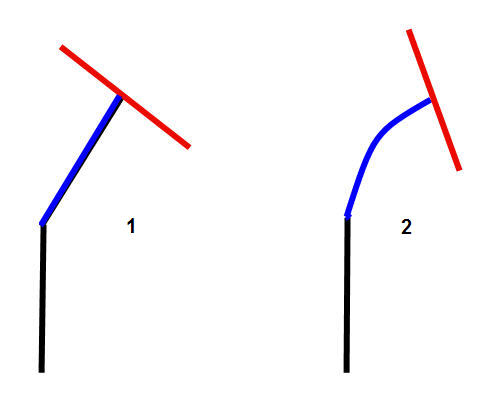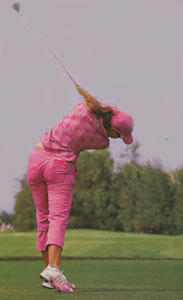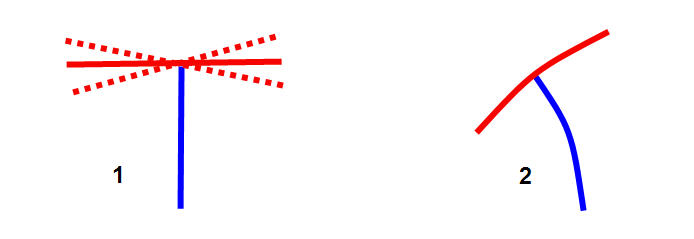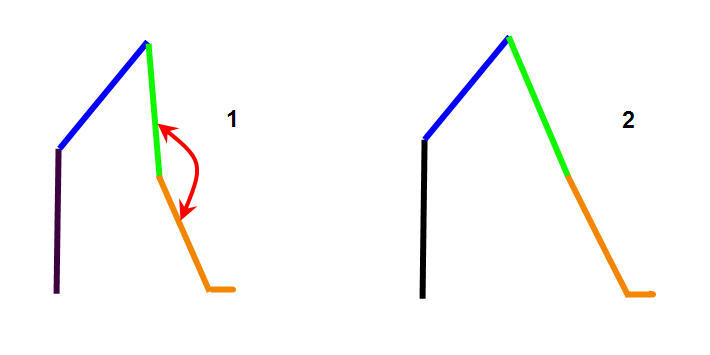I think that the issue of the right shoulder shoulder's motion in the downswing is very complex because many biomechanical factors affect its directional motion.
TGM only mandates that the right shoulder move downplane. Many golfers (like Natep) incorrectly believe that the term "downplane" means that the right shoulder must move down straight towards the ball. However, I think that it is better to think of "downplane" as being a zone of directional motion.
Consider Sergio Garcia at the end-backswing position.

The red zone represents the "downplane" zone, and if his right shoulder moves into that zone in the downswing then it can be correctly labelled as moving downplane. The yellow zone is a horizontal zone and if the right shoulder moves into that zone in the downswing, then the right shoulder is moving too horizontally. If the right shoulder drops down into the blue zone, then it is moving too vertically downwards.
When the right shoulder moves downplane during the downswing, it doesn't move along a single planar path in the red zone, and the path can be continuously changing during the duration of the downswing due to multiple interacting biomechanical factors. Here is a discussion of the factors involved.
The first factor that affects the steepness of the right shoulder's motion is the spinal bend inclination angle.

This diagram shows the legs (black), spine (blue) and shoulder turn angle (red) as seen from a DTL view. Presuming that the shoulders turn perpendicularly to the spine, one can see that the shoulder turn angle will be more vertical (steeper) if the spinal bend inclination angle is greater (and the golfer is more bent over at the level of the hip joints). Keegan Bradley is an example of a golfer who has a more bent-over posture, while Mickelson is an example of a golfer who has a more erect posture.
The second biomechanical factor in play is whether the spine remains relatively straight or whether there is some forward bend in the spine.

Diagram 1 shows a golfer who maintains a relatively straight spine in his downswing action. If the shoulders turn perpendicularly to the upper thoracic spine, then they will also be turning perpendicularly to the spinal bend inclination angle if the spine is straight.
Diagram 2 shows a golfer who has a lot of forward bend (in the direction of the ball-target line) involving the lower-mid thoracic spine and that will steepen the right shoulder's downplane motion during the downswing.
Paula Creamer is an example of golfer who has a lot of forward spine bend in her mid-thoracic spine.

One can readily see how forward bend of the mid-thoracic spine steepens the shoulder turn angle.
However, the issue is more complex because the spine can also bend sideways (lateral bend) at the
same time, and the right shoulder can
simultaneously become depressed.

Diagram 1 depicts the spine from a face-on view if a person stands erect with a straight spine.
The spine is blue and the shoulder turn angle is red. The shoulders are oriented perpendicularly to the spine if the clavicles are horizontal to the ground. The red dotted lines show the range of depression/elevation of the shoulders if a person deliberately decides to elevate/depress the shoulders (which can happen unilaterally or bilaterally) and that changes the shoulder turn angle relative to the spine.
Diagram 2 shows a face-on view of a golfer who has i) secondary axis tilt (rightwards tilt of the spine) combined with ii) some lateral bending of the spine iii) combined with some depression of the right shoulder.
Jamie Sadlowksi manifests this phenomenon to a significant degree in his downswing action.

One can clearly see the three biomechanical phenomena in JS's downswing action - i) secondary axis tilt, ii) lateral bending of the thoracic spine relative to the lumbar spine, and iii) depression of the right shoulder.
Each individual golfer can manifest all these biomechanical factors to a variable degree and there is therefore great variability in the right shoulder's directional motion in the downswing in different golfers.
Not only is there is a great variability in right shoulder motion between different golfers, there is also great variability in i) the angulation of the left arm relative to the torso and ii) the accumulator #3 angle between the left arm and the clubshaft.

This diagram represents a DTL view of a golfer at impact.
The black line represents the legs. The blue line represents the spine (and mid-upper torso) angle. The green line represents the angle of the left arm relative to the spine/torso. The orange line represents the clubshaft. The red double-arrowed line shows the accumulator #3 angle between the left arm and the clubshaft.
Diagram 1 represents a golfer whose left arm is near-vertical at impact and who has a significant accumulator #3 angle. Sergio Garcia and Hunter Mahan fall into this category.
Diagram 2 shows a golfer with the left arm stretched-out away from the body and with far less accumulator #3 angle. Phil Mickelson and Moe Norman manifest this pattern.
Here is Sergio Garcia

Here is Phil Mickelson

I know of no biomechanical/mechanical law that dictates that the right shoulder must move along a directional path that is parallel to the clubshaft's planar path in the downswing - considering the fact that all these biomechanical/mechanical variables are in play to a variable degree in each individual golfer's downswing action. I think that BM and Mike Jacobs deal with this complex issue in an overly simplistic manner.
Jeff.